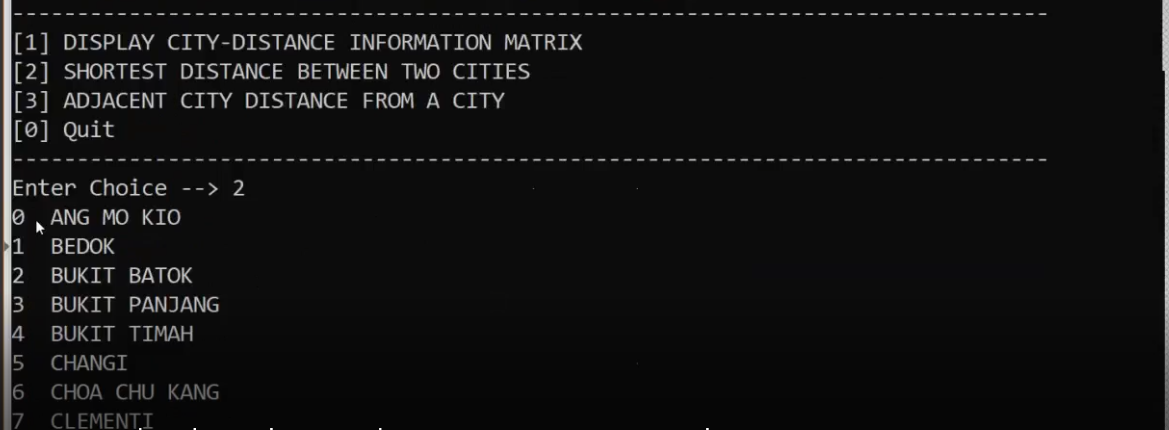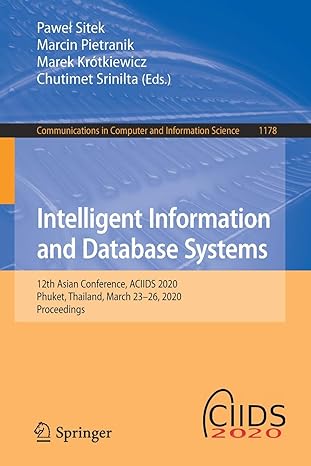Question
Need help with this java code to print the same output shown below public class PrintAdjacencyMatrix { public static void main(String[] args) { // adjacency
Need help with this java code to print the same output shown below
public class PrintAdjacencyMatrix { public static void main(String[] args) { // adjacency matrix int [][] distance = {{-1,-1,18,16,-1,-1,-1,-1,-1,-1,-1,6,-1,-1,-1,-1,-1,-1,6,-1,-1,-1,5,-1}, //0 {-1,-1,-1,-1,22,-1,-1,-1,-1,-1,16,-1,16,-1,-1,-1,-1,-1,-1,5,13,-1,16,-1}, {18,-1,-1,7,5,7,-1,6,19,-1,-1,-1,-1,-1,-1,-1,-1,-1,-1,-1,-1,16,-1,-1}, {16,-1,7,-1,6,-1,-1,4,-1,15,-1,16,-1,-1,-1,-1,-1,-1,-1,-1,-1,-1,14,11}, {-1,22,5,6,-1,5,-1,-1,25,-1,-1,-1,-1,-1,-1,9,-1,-1,-1,-1,10,-1,11,-1}, {-1,-1,7,-1,5,-1,-1,-1,-1,-1,-1,-1,-1,7,-1,5,-1,-1,-1,-1,-1,-1,-1,-1}, {-1,-1,-1,-1,-1,-1,-1,-1,-1,-1,-1,-1,-1,-1,-1,-1,-1,-1,16,5,18,-1,-1,-1}, {-1,-1,6,4,-1,-1,-1,-1,22,-1,-1,-1,-1,-1,-1,-1,-1,-1,-1,-1,-1,15,-1,11}, {-1,-1,19,-1,25,-1,-1,22,-1,-1,-1,-1,-1,-1,-1,-1,-1,-1,-1,-1,-1,19,-1,-1},//8 {-1,-1,-1,15,-1,-1,-1,-1,-1,-1,-1,3,-1,-1,-1,-1,6,-1,-1,-1,-1,-1,-1,8},//9 {-1,16,-1,-1,-1,-1,-1,-1,-1,-1,-1,-1,2,-1,-1,-1,-1,-1,-1,-1,10,-1,-1,-1},//10 {6,-1,-1,16,-1,-1,-1,-1,-1,3,-1,-1,-1,-1,-1,-1,5,-1,-1,-1,-1,-1,-1,9},//11 {-1,16,-1,-1,-1,-1,-1,-1,-1,-1,2,-1,-1,-1,-1,5,-1,6,-1,-1,8,-1,-1,-1},//12 {-1,-1,-1,-1,-1,7,-1,-1,-1,-1,-1,-1,-1,-1,-1,6,-1,8,-1,-1,-1,-1,-1,-1},//13 {-1,-1,-1,-1,-1,-1,-1,-1,-1,-1,-1,-1,-1,-1,-1,-1,-1,-1,-1,8,-1,-1,-1,-1},//14 {-1,-1,-1,-1,9,5,-1,-1,-1,-1,-1,-1,5,6,-1,-1,-1,10,-1,-1,9,-1,10,-1},//15 {-1,-1,-1,-1,-1,-1,-1,-1,-1,6,-1,5,-1,-1,-1,-1,-1,-1,-1,-1,-1,-1,-1,5},//16 {-1,-1,-1,-1,-1,-1,-1,-1,-1,-1,-1,-1,6,8,-1,10,-1,-1,-1,-1,-1,-1,-1,-1},//17 {6,-1,-1,-1,-1,-1,16,-1,-1,-1,-1,-1,-1,-1,8,-1,-1,-1,-1,12,6,-1,8,-1},//18 {-1,5,-1,-1,-1,-1,5,-1,-1,-1,-1,-1,-1,-1,-1,-1,-1,-1,12,-1,15,-1,-1,-1},//19 {-1,13,-1,-1,10,-1,18,-1,-1,-1,10,-1,8,-1,-1,9,-1,-1,6,15,-1,-1,6,-1},//20 {-1,-1,16,-1,-1,-1,-1,15,19,-1,-1,-1,-1,-1,-1,-1,-1,-1,-1,-1,-1,-1,-1,-1},//21 {5,16,-1,14,11,-1,-1,-1,-1,-1,-1,-1,-1,-1,-1,10,-1,-1,8,-1,6,-1,-1,-1},//22 {-1,-1,-1,11,-1,-1,-1,11,-1,8,-1,9,-1,-1,-1,-1,5,-1,-1,-1,-1,-1,-1,-1}}; //23 //Printing the header System.out.println("============================== "+ " ADJACENCY MATRIX OF SINGAPORE "+ "=============================="); // Printing the location index numbers for(int i=0;i
Dijkstra:
import java.util.ArrayList; import java.util.Collections; import java.util.List; import java.util.PriorityQueue;
public class Dijkstra { public void computePath(Vertex sourceVertex) { sourceVertex.setMinDistance(0); PriorityQueue priorityQueue = new PriorityQueue(); priorityQueue.add(sourceVertex);
while (!priorityQueue.isEmpty()) { Vertex vertex = priorityQueue.poll();
for (Edge edge : vertex.getEdges()) { Vertex v = edge.getTargetVertex(); double weight = edge.getWeight(); double minDistance = vertex.getMinDistance() + weight;
if (minDistance
public List getShortestPathTo(Vertex targetVerte) { List path = new ArrayList();
for (Vertex vertex = targetVerte; vertex != null; vertex = vertex.getPreviosVertex()) { path.add(vertex); }
Collections.reverse(path); return path; } }
App:
public class App { public static void main(String[] args) { Vertex v1 = new Vertex("A"); Vertex v2 = new Vertex("B"); Vertex v3 = new Vertex("C");
v1.Add_neighbour(new Edge(1, v1, v2)); v1.Add_neighbour(new Edge(10, v1, v2));
v2.Add_neighbour(new Edge(1, v2, v3));
Dijkstra dijkstra = new Dijkstra(); dijkstra.computePath(v1);
System.out.println(dijkstra.getShortestPathTo(v3)); } }
Edge:
public class Edge { private double weight; private Vertex startVertex; private Vertex targetVertex;
public Edge(double weight, Vertex startVertex, Vertex targetVertex) { this.weight = weight; this.startVertex = startVertex; this.targetVertex = targetVertex; }
public double getWeight() { return weight; } public Vertex getStartVertex() { return startVertex; }
public Vertex getTargetVertex() { return targetVertex; }
public void setWeight(double weight) { this.weight = weight; }
public void setStartVertex(Vertex startVertex) { this.startVertex = startVertex; }
public void setTargetVertex(Vertex targetVertex) { this.targetVertex = targetVertex; } }
Vertex:
import java.util.ArrayList; import java.util.List;
public class Vertex implements Comparable { private String name; private List edges; private boolean visited; private Vertex previosVertex; private double minDistance = Double.MAX_VALUE;
public Vertex(String name) { this.name = name; this.edges = new ArrayList(); }
public void Add_neighbour(Edge edge) { this.edges.add(edge); }
public List getEdges() { return edges; }
public void setEdges(List edges) { this.edges = edges; }
public boolean isVisited() { return visited; }
public void setVisited(boolean visited) { this.visited = visited; }
public void setPreviosVertex(Vertex previosVertex) { this.previosVertex = previosVertex; }
public void setMinDistance(double minDistance) { this.minDistance = minDistance; } public Vertex getPreviosVertex() { return previosVertex; }
public double getMinDistance() { return minDistance; }
@Override public String toString() { return name; }
@Override public int compareTo(Vertex otherVertex) { return Double.compare(this.minDistance, otherVertex.minDistance); } }
Java code output has to appear something like this, showing the start from, To, path, and total distance after entering the integer starting point and integer end point.


Here is the requirements needed for the question (need help with requirement 2,3, and 4)


Picture of adjacency matrix for viewing of distance (Do download to zoom)

Step by Step Solution
There are 3 Steps involved in it
Step: 1

Get Instant Access to Expert-Tailored Solutions
See step-by-step solutions with expert insights and AI powered tools for academic success
Step: 2

Step: 3

Ace Your Homework with AI
Get the answers you need in no time with our AI-driven, step-by-step assistance
Get Started


